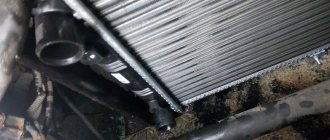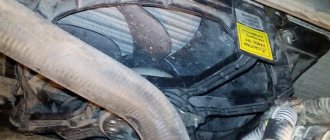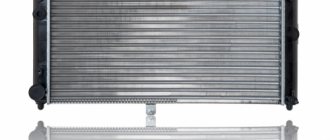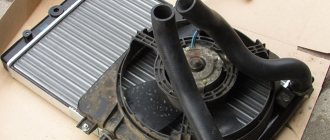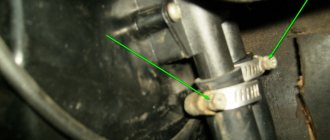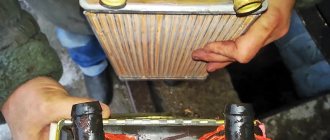One of the reasons for poor heater performance is the heater radiator. During the operation of the car, it begins to leak and is no longer able to transfer the required amount of heat to the interior. Depending on the year of manufacture and configuration of the Lada Priora, the process of removing the stove (radiator) can vary greatly.
Replacing the cooling radiator on a Lada Priora without air conditioning (+part numbers)
The cooling radiator on the Priora is its sore spot . Anyone who has owned this car for a long time knows that it often starts to leak in a place closer to the pipes.
Traces of smudges are visible on the sides.
A simple and clear video about the replacement.
Another common reason for replacement is a broken steam hose fitting.
Replacing the cooling radiator
To replace you will need:
- head on 10
- keys for 8 and 10
- cross screwdriver _
- a container for draining antifreeze (for me it was a basin and a barbecue jar).
- rags.
Algorithm
- First you need to disconnect the minus . For any work, I recommend turning off the mass.
- Move the air filter housing aside, or better yet, remove it. To do this, disconnect the MAF chip and unscrew the clamp . The housing is easy to remove.
If you simply move the case to the side, access to the radiator will be difficult.
You can't really see it in the photo above, I marked the places on the new radiator.
Location of the drain plug.
If this leaks, then change the entire cooling system fluid! My friendly advice to you!
I didn’t take a photo of the fastening under the hood, but I found this.
By the way, the steam outlet pipe broke off. Traces of coolant leakage are visible.
Before “installing” a new radiator, I would recommend installing the old one a couple of times - for training. You must press carefully so as not to damage the honeycomb.
Articles
I bought it for 1820 rubles. Fits perfectly. A native one costs about 2,500 rubles.
Source
What is this?
A radiator is usually understood as a spare part that serves to cool the engine while it is running.
The auto radiator, regardless of the type, has the following design:
- Bottom tank.
- Upper container.
- Pipes.
- Core.
The following may cause damage to this spare part:
- Depressurization of the tank.
- Coking of internal cavities.
- Using low quality coolant.
- Damage to the grille.
- Hose rupture.
The owner of a Priora will understand that the radiator device is broken by the following signs:
- Plumes of smoke appearing from under the hood.
- Motor overheating.
- The car stalls.
- The engine will not start.
If such symptoms appear, you should contact a service station as soon as possible. It happens that it is possible to restore a failed part. But if most of the elements are worn out, the specialist advises changing the spare part. It is better to buy a new product: old ones do not last long.
Replacing the cooling radiator on a Priora
Welcome! Cooling radiator - included in the cooling system, when the engine is running, the coolant runs in a circle and most of it is in the cooling radiator; when driving at speed, the radiator is cooled by the air flow, due to which the liquid cools down and the engine does not heat up much.
Note! To change the radiator in a car, you will need: All the keys that are in your arsenal, and you will also need screwdrivers, containers into which you will drain the coolant (Or one large container), and stock up on new Coolant, because you will need to drain the old one and if If it is in poor condition, it is better to fill the radiator and expansion tank with good fresh fluid after assembly!
Where is the cooling radiator located? It is located in the front part of the body, secured with nuts, they attach it to the TV (the TV is the very front part, where the headlights are, it also connects the bumper and side members), removing the radiator on Priors is not very difficult, since there is enough space , so that you can crawl with your hands, but still, if you stock up on the right keys, the replacement process will be completed much faster, namely, the wrench and sockets for it will be very useful.
Types
Radiators can be of the following types depending on the material of manufacture:
- Copper.
- Steel.
- Aluminum.
Steel ones are used extremely rarely today. More often, cars are equipped with aluminum spare parts. They have good heat transfer characteristics and are reasonably priced. Copper devices are considered to be of higher quality. But they are expensive.
Auto radiators can also be divided into:
- Liquid (cooling occurs due to circulation in the coolant system).
- Oil (parts are located in an oil bath).
Radiator devices are also classified according to the shape of the pipes. There are parts with round and oval tubes. Heat transfer is higher for products with oval-shaped pipes. That's why they cost more.
We sell soldered and prefabricated parts. The former are considered to be of higher quality and reliability, they have higher heat transfer.
According to the coolant flows, radiators are:
- One-way.
- Two-way.
- Three-way.
Based on the coolant inlet, radiators are divided into:
- Transverse.
- Longitudinal.
By orientation, the spare part can be:
- Horizontal.
- Vertical.
Radiators for Priora are sold:
- Original.
- Unoriginal.
The latter type is cheaper.
Parts are presented at points of sale by the following brands:
- AvtoVAZ.
- LUZAR.
- Miles.
- Termal.
- NISSENS.
- Panasonic.
- DAAZ.
- SAT.
Car radiators for Priora are sold in different places. Depending on this, all spare parts can be divided into:
- Purchased at the car market.
- Ordered from an online auto parts store.
- Purchased from a store that specializes in selling domestic and foreign-made parts.
How to replace the cooling radiator on a VAZ 2170-VAZ 2172?
Removal: 1) Before starting work, drain all the coolant from the radiator (How to drain the liquid, read “here”) and proceed to removing the electric fan (If you don’t remove it, you simply won’t pull out the radiator), to do this, remove it first the negative terminal from the battery by loosening the bolt that secures it, then remove the air filter housing because it will get in the way very much (Read “here” how to do this), well, you can start removing the electric fan, first disconnect the wiring from each other , the wiring of the electric fan goes on the side in the form of a connector and block (see photo 1), then unscrew (it’s easiest to use a wrench) two bolts that secure the electric fan to the casing on the left and four nuts, two of which are located on the top and two below (see photos 2 and 3 below) and then remove the electric fan by pulling it to the top and putting it aside.
2) Next, remove the sound signal, because it will not allow you to remove the radiator (For information on how to do this, read the article: “Replacing the signal on the Lada Priora”) and then loosen all the clamps that secure all the supply pipes to the radiator (see. photos 1 and 2, pay attention to photo 1, there is another pipe indicated by an arrow, so don’t miss it) and disconnect them, immediately after which unscrew the two nuts that secure the radiator to the body (see photo 3) and then remove a holder that keeps the hose from dangling from the hole in the cross member of the engine compartment (see photo 4), and that’s it, you can safely then tilt the radiator towards the car engine and then pull it out of the engine compartment.
Replacing the Lada Priora cooling radiator
On a Lada Priora, a radiator replacement is required if a coolant leak is detected. The usual symptoms of this are: insufficient engine cooling, coolant quickly decreases, and traces of antifreeze are observed.
Please note that if you discover a breakdown, then if you repair it yourself, you will need to replace the radiator, since repairs can only be carried out in specialized workshops with special equipment.
It is also not recommended to use sealants and similar products to eliminate leaks on the Priora. When using them, the cooling elements become clogged and further repairs will be more expensive.
— Pliers with long lips
— A basin or any container to drain the coolant.
Design and functions of the Lada Priora radiator
The main task of this unit is cooling and maintaining the operating temperature of the coolant. When starting a cold engine, the radiator does not affect the cooling system in any way. Moreover, until the engine warms up, it is not turned on at all, since it is used only when a large circle of the cooling system is opened.
After reaching a certain temperature (on the Lada Priora it is 85–90 degrees), the thermostat opens and antifreeze begins to circulate through the radiator, where it cools. When the engine operates at high speeds (especially when driving at low speeds), the device cannot cope with cooling, and the engine temperature begins to rise again. In this case, the fan for forced cooling of the antifreeze circulating through the radiator is turned on to help.
Structurally, it consists of a tank at the top and bottom, the middle part and fastening elements.
The standard cooling radiator on the Lada Priora is made of brass parts. And this is a material with excellent thermal conductivity characteristics. The middle part, or core, is a plate structure through which tubes are passed, connected to the plates by soldering. As the coolant passes through the core, it is distributed into a number of separate streams. This allows antifreeze to be cooled more efficiently by significantly increasing the contact area between the antifreeze and the metal walls of the vertical tubes.
The radiator tanks are connected to the cooling system using rubber pipes. A special tap is used on the lower tank to make it easier to drain the coolant. There is also an additional tap on the cylinder block. With its help, you can easily drain the liquid from the engine water jacket. Overall, a simple but effective heat exchanger design.
Step-by-step instructions for replacing the engine radiator on a VAZ 2170 Priora:
— First of all, drain the antifreeze/antifreeze from the system. To do this, open the expansion tank, then unscrew the drain plug, after placing a container under it.
— Remove and carefully pull out the fan casing, to do this you need to disconnect the wires and unscrew the fasteners.
— We remove the signal
— Next, loosen the clamps and disconnect the compression and outlet pipes.
— Unscrew the radiator mounts to the body...
...then disconnect the fastening element of the expansion tank hose to the front panel.
— Loosen the hose clamp and disconnect it.
— After this, you can pull out the radiator and remove the 2 lower cushions and mounting bushings.
Note: to repair the radiator yourself, rinse it thoroughly and inspect it for cracks in the plastic elements. If they are discovered, it will not be possible to repair it. If not, then plug the pipes and lower them into water. Apply air to detect leaks.
— replacing the radiator on a VAZ 2170 occurs in the reverse order (do not forget to first install the lower mounting pads and the upper mounting bushings).
You can also apply a thin layer of sealant before connecting the hoses to prevent further leaks.
— Install the fan with a casing, fill with antifreeze.
Device and features
The cooling system of the Priora internal combustion engine has a standard set of main components:
- radiator;
- thermostat;
- electric fan;
- water pump;
- heater;
- engine jacket;
- connecting hoses;
- expansion tank.
By circulating through the large and small circuits, the coolant prevents the engine from overheating, maintaining the desired temperature. Structurally, the cooling system of the Priora is simple and no different from other internal combustion engines with an injector, with the exception of small parts.
Radiator and forced cooling fan
They mainly serve to bring the working fluid to the optimal temperature for the functioning of the engine (the operating temperature of the Priora engine with 16 valves is 90–95 degrees). The predecessor of the Priora VAZ 2110 often installed a cooler made of copper alloys, but due to cheaper prices, designers switched to aluminum analogues.
The operation of the fan depends on the engine control unit.
It receives information from the DTOZH (this is a sensor that reads temperature readings) located in the water jacket of the power unit. If the permissible temperature values are exceeded, the control unit connects an electric fan to improve cooling efficiency. A faulty fan or clogged radiator can lead to a constant increase in optimal engine temperatures, which shortens the service life and can cause costly repairs.
Thermostat
Its task is to promptly open coolant access to a large circle of the engine cooling system (engine cooling system) after the engine reaches the optimal temperature. In simple terms, the thermostat allows you to quickly warm up the engine and regulates the operation of the entire system. During warming up, the thermostat valve is in the closed position, antifreeze does not flow through the large circuit (the radiator is not activated). As it warms up, the valve opens slightly under the influence of rising temperature, and antifreeze begins to move through the radiator along a larger circuit.
A thermostat malfunction can result in overheating of the power unit (if the valve is stuck closed) or, conversely, the operating temperature rises very slowly (when the valve is stuck in the open position). Overheating is much more dangerous. Beginners can identify this malfunction if the engine heats up all the time and the fan on the Priora is constantly running.
Pump (water pump) and heater
Without the first part, the coolant circulation circuit in the system is impossible. If the water pump is faulty, at best there will be a coolant leak from the system. In the worst case, the pump may jam, which will lead to a broken timing belt and subsequent problems, the solution of which will result in expensive repairs.
The heater, or simply the stove, consists of a radiator, pipes and a fan. Can additionally cool the antifreeze in the system. An indispensable unit in winter. Provides the interior with warm air.
Connecting elements and expansion tank
It serves as a receiving compartment where gases and vapors are discharged when the coolant is heated. Also, the expansion tank is the level for the entire cooling system. One of the main elements in the tank is the valve cover through which air is forced out. There is antifreeze, it begins to boil when the engine temperature rises critically.
The connecting hoses serve as a pipeline for the circulation of coolant and connecting elements of all structural units, thus creating a single looped and sealed circuit.
The design of the cooling system also includes an engine temperature sensor on the Priora and an engine jacket. The sensor constantly reads information about the current antifreeze temperature and transmits it to the ECU. The location of the power plant jacket is structurally assumed in the cylinder block housing; it serves to remove heat through the coolant.
Features of replacing the radiator on a Lada Priora with air conditioning.
There are 3 types of radiators installed on Priora: prefabricated aluminum, for cars without a climate system, and 2 types soldered for Hala and Panasonic air conditioners.
The heat transfer of soldered radiators on a Lada Priora with air conditioning is 1.5 times higher. First, the condenser, which is located in front of the engine cooling radiator, is cooled. So, by installing the wrong type of product, you can create additional problems in the form of engine overheating. It is also worth paying attention to the fact that insufficient cooling may occur due to low pump performance.
Features of cooling system malfunctions
The efficiency of the structure primarily depends on the level of antifreeze in the system and its condition (this liquid has a certain resource, usually up to three years or up to 50,000 km). The main sources of system malfunctions are the thermostat, radiator and electric fan, as well as the water pump, the principle of operation of which is described above.
The radiator most often becomes the source of antifreeze leakage. Accordingly, the liquid level in the system drops, and there is not enough of it for effective heat removal. The motor begins to overheat. It can also be clogged with garbage. And if water is used instead of antifreeze the old fashioned way, scale may form.
The consequences of a faulty water pump are much more serious. In addition to antifreeze leakage, the circulation of coolant in the system may stop and, as a result, the engine will quickly overheat. The worst case scenario is bent valves due to a broken timing belt.
The next common malfunction is burnout of the cylinder head gasket or deformation of the cylinder head of the internal combustion engine system. This leads to coolant entering the fuel combustion chambers. The same thing can happen if cracks appear on the cylinder block.
Coolant leakage is most often associated with loss of tightness of the connecting pipes, because over time, the material from which they are made hardens and wears out, as a result of which it cannot work properly.
On a Priora, a lot depends on the computer, and a faulty coolant temperature sensor can give incorrect readings. For example, if the ECU receives underestimated performance, the engine will begin to overheat. Otherwise, the fan will be constantly on. On the other hand, often the cooling system sensor does not transmit any readings at all. Then the ECU switches the operation to emergency mode.
Causes of malfunctions
Why do problems occur in cooling systems? The following factors usually play a role:
- natural wear and tear of components;
- mechanical damage;
- operation of the engine in violation of maintenance rules;
- failures in the electronics (for example, an error in the Priora coolant temperature sensor).
In addition, breakdowns can be caused by low-quality spare parts and coolant, mixing antifreeze of different brands, and unqualified repair work. If problems occur with the cooling system, they should be addressed immediately. In some cases, ignoring problems will cause complete failure of the power unit.
This can happen due to coolant getting into the oil sump or engine overheating due to low fluid level (a faulty thermostat can also be one of the reasons). In turn, operating an overheated motor leads to its jamming. Considering these facts, we can conclude that the cooling system must be constantly monitored. The antifreeze level should always be normal; the coolant that has exhausted its life should be changed in a timely manner.
You can notice problems yourself; for this there is no point in contacting a car service.
And repair work on replacing and servicing the cooling system of the Lada Priora can be done with your own hands. There is nothing complicated about this. With the exception, perhaps, of the pump, where you will have to deal with installing a timing belt. In this case, it is better for beginners to entrust the procedure to professionals. Depending on the region, the cost of such services does not exceed 1,500 rubles, and this is the most expensive system repair operation; the rest are priced less.
Signs of trouble
Problems can be identified by obvious symptoms.
| What's happening | What the instruments show and how the nodes behave | Probable Causes |
| Engine overheating. | A light on the instrument panel lights up indicating this. This can also be recognized by the arrow of the coolant temperature indicator on the same instrument panel. If the indicator is faulty, overheating will be indicated by a cooling fan running almost continuously. Systematic overheating of the engine can be determined by the spark plugs - a white coating appears on them; in good condition the engine has a sand-colored coating. | If the engine overheats, there may be a coolant leak from the system. |
| Another sign of a malfunctioning cooling system is a cold engine, which for a long time (especially in winter) cannot warm up to the optimal temperature. | This can be seen from the readings on the dashboard. You can also understand this by turning on the heater. In such situations the air will be cool. | Thermostat stuck open. Operating a cold engine under normal loads is not allowed. |
To determine the cause, you should visually check all pipes and elements of the system for leaks.
If no leaks were detected externally, and the level of antifreeze in the tank is still decreasing, then perhaps the problem is internal leaks.
This is much more dangerous, because antifreeze gets into the oil. You can determine it by the color of the exhaust gases: in such cases, the smoke will be white. In addition, the engine oil level becomes higher.
Methods for diagnosing faults
Identifying problems in the Priora cooling system begins with checking the coolant level in the expansion tank. Optimally – between the minimum and maximum. An antifreeze level below the minimum mark is unacceptable, as this will cause overheating. If the antifreeze is cloudy, with impurities, it means its service life has expired and should be replaced. It is advisable to flush the cooling system before doing this. If, after topping up, the antifreeze still disappears somewhere, then you need to check the tightness and presence of leaks on the expansion tank, pump, connecting pipes, etc. There may also be a leak on the radiator, including the heater.
If the level is normal, but the Priora engine gets hot, then the reason is a faulty thermostat. It's easy to check its operation. Start the cold engine and let it idle for a while. If the thermostat is working properly, the lower part of the radiator will gradually heat up. If the lower radiator pipe begins to heat up immediately, it means that the thermostat is stuck in the open position and antifreeze immediately circulates in a large circle on a cold engine. The thermostat cannot be repaired and must be replaced if a problem occurs.
A much more serious problem is a faulty pump. You can determine the breakdown in this way.
- The engine temperature rises quickly immediately after starting.
- Noise in the area of the water pump during operation of the power plant.
- Antifreeze leaks under the pump.
The noise of the pump indicates a worn bearing, and rapid heating is associated with a lack of coolant circulation. Antifreeze leaks indicate a failed oil seal.
The water pump cannot be repaired and must be replaced.
